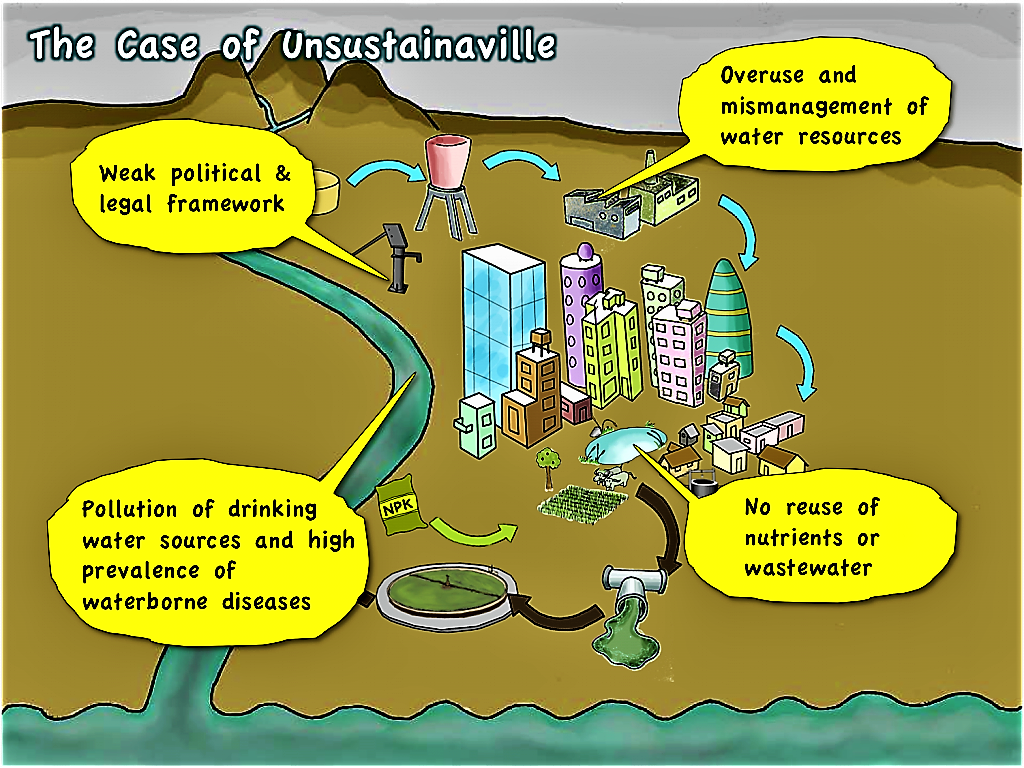Now What?
This analysis should provide you with quite a good first overview of your local water and sanitation situation. But now, you may have identified many problems and may be overwhelmed and insecure where to continue. In that case, it is sensible to group the problems into certain problem areas (problems that are linked to one another), and to try to identify root causes for the problem. See how this was done in the case of Unsustainaville:
In Unsustainaville, four main problem areas emerged:

Problem Area 1: Weak Political and Legal Framework
In Unsustainaville, the political and legal framework is very weak. There are some laws and policies, but they are not very coherent. Furthermore, the bodies that should control their implementation are weak, and do not have enough power to enforce the laws. The following problems result from this root cause:
- Wastewater can be discharged into the open (also by industries) without any legal consequences. The environmental standards are very low.
- This leads to a severe pollution of groundwater and surface water sources. Due to this fact, the water that is used do supply the distribution grid is of a bad quality. Chlorination cannot deal with all the pollutants present.
- The policy that industries get their water for free undermines any endeavours to cut down water use.
These problems are mainly not technical in their character. You will need software tools to tackle them. See for instance creating an enabling environment (see wastewater treatment) or command and control tools (see Water Purification), or planning and process tools for more information.
Problem Area 2: Overuse and Mismanagement of Water Resources
Though water is not abundant in Unsustainaville, it is mismanaged and overused, leading to the following problems:
- Among the inhabitants of Unsustainaville, there is no awareness on the city's water problems. Water is wasted in households, in industry and in agriculture. This leads to the fact that there is a large volume of wastewater to be treated. The wastewater treatment plant is overloaded and does not work any more, leading to the discharge of raw wastewater with all its negative consequences for humankind and the environment.
- The groundwater level of Unsustainaville has been decreasing drastically over the last few years. As a result, Unsustainaville must now also use riverwater as a source of water. This leads to allocation problems with those living further downstream.
- There is no plan to recharge groundwater.
- The decreasing groundwater table puts the existence of many small scale farmers, which rely on shallow wells, into danger. This causes an additional conflict potential in the area, and furthermore threatens the existence of thousands of families.
First, awareness raising (see PPT) and advocacy may help the decision makers and the local population of Unsustainaville to understand the problem. You could also check out existing planning approaches or concepts such as IWRM or water safety plans.
Problem Area 3: No Reuse of Nutrients or Wastewater
The fact that there is neither a concept for the reuse of wastewater nor for nutrients is the cause for several further problems:
- Groundwater is used as a source of water, but none of this water is used to recharge groundwater sources after treatment. This leads to the fact that the groundwater level is decreasing.
- Valuable nutrients present in wastewater are not used. On the other hand, farmers have to buy artificial fertilisers that are imported from abroad, weakening the local economy. On the other hand, nutrients present in the wastewater are just wasted, leading to eutrophication and pollution of water sources.
To find out more about recharge and reuse, check out the recharge and reuse section of the implementation tools.
Problem Area 4: Pollution of Drinking Water and High Prevalence of Waterborne Diseases
The absence of adequate methods to treat wastewater leads to severe water pollution:
- Methods of drinking water purification are not known or not sufficient, leading to many infant deaths and a high prevalence of waterborne diseases.
- When people are ill, they cannot attend school or work; these factors are crucial for people's poverty.
To find out more about drinking water treatment, see water purification section of the implementation tools.
Having identified problems in relation to water and sanitation in your areas, there are now different ways to proceed:
→ Refer to the planning and process Tools section to find approaches on how problems can be tackled
→ Refer to the respective section of the Implementation Tools:
- Water sources
- Water purification
- Water distribution
- Water use
- Wastewater collection
- Wastewater treatment
- Recharge and reuse
Remember: The conclusion you draw from a first desktop analysis may not necessarily be the same than the one that other stakeholders draw. It is important to redo this exercise with stakeholders and identify the most problematic areas jointly. In any case, no matter which area you identified as the most problematic - this analysis should also make you clear that your problem never stands alone, but is always linked to other ones through the water and nutrient cycles.
Previous Step
Go back to previous step ----> What sources of fertilisers are used?
